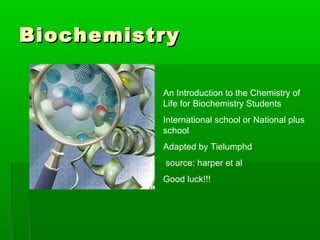
Biochemistry biomolecules
- 1. Biochemistry An Introduction to the Chemistry of Life for Biochemistry Students International school or National plus school Adapted by Tielumphd source: harper et al Good luck!!!
- 2. What is Life Made of? Physical and Chemical sciences alone may not completely explain the nature of life, but they at least provide the essential framework for such an explanation. All students of life must have a fundamental understanding of organic chemistry and biochemistry.
- 3. Organic Chemistry Organic chemistry is the study of Carbon compounds. Organic compounds are compounds composed primarily of a Carbon skeleton. All living things are composed of organic compounds.
- 4. Organic Chemistry What makes Carbon Special? Why is Carbon so different from all the other elements on the periodic table? The answer derives from the ability of Carbon atoms to bond together to form long chains and rings.
- 6. Organic Chemistry Carbon can covalently bond with up to four other atoms.
- 7. Carbon can form immensely diverse compounds, from simple to complex. Methane with 1 Carbon DNA with tens of Billions of atom Carbon atoms
- 8. Biochemistry Biochemistry is a special branch of organic chemistry that deals with matter inside the living cell called Protoplasm. Protoplasm is an enormously complex mixture of organic compounds where high levels of chemical activity occur.
- 9. Biochemistry How much biochemistry do you need to know for this 2. You will be course? expected to learn the basic 1. You need to know biochemical the structure of processes of organic molecules major cell important to major functions, such as biological processes. photosynthesis, respiration, and protein synthesis.
- 10. Primary Organic Compounds You are expected 1. Carbohydrates to learn the 2. Lipids structure and functions of these 3. Proteins organic 4. Nucleic Acids compounds:
- 11. Polymers ands Monomers Each of these types of molecules are polymers that are assembled from single units called monomers. Each type of macromolecule is an assemblage of a different type of monomer.
- 12. Monomers Macromolecule Monomer Carbohydrates Monosaccharide Lipids Not always polymers; Hydrocarbon chains Proteins Amino acids Nucleic acids Nucleotides
- 13. How do monomers form polymers? In condensation reactions (also called dehydration synthesis), a molecule of water is removed from two monomers as they are connected together.
- 15. Hydrolysis In a reaction opposite to condensation, a water molecule can be added (along with the use of an enzyme) to split a polymer in two.
- 17. Carbohydrates Carbohydrates are made of carbon, hydrogen, and oxygen atoms, always in a ratio of 1:2:1. Carbohydrates are the key source of energy used by living things. The building blocks of carbohydrates are sugars, such as glucose and fructose.
- 18. Carbohydrates What do the roots mono-, di-, oligo-, and poly mean? Each of these roots can be added to the word saccharide to describe the type of carbohydrate you have.
- 19. How do two monosaccharides combine to make a polysaccharide?
- 20. Polysaccharides
- 21. Lipids Lipids are molecules that consist of long hydrocarbon chains. Attaching the three chains together is usually a glycerol molecule. Lipids are NONpolar.
- 23. Proteins Proteins are building blocks of structures called amino acids. Proteins are what your DNA codes to make (we will talk about this in great detail in a month or so). A peptide bond forms between amino acids by dehydration synthesis.
- 25. Protein Structure Level Description Primary The amino acid sequence Helices and Sheets Secondary Disulfide bridges Tertiary Multiple polypeptides Quaternary connect
- 26. Primary structure analogy means...... Primary data Primary data Kovalen bonds Kovalen bonds
- 27. Salmonelle colonies count by...... These were their kuantitative counting By using colony counting methods Must searching more spesific methode to repair this standart methode.
- 28. Drug discovery today were combining between
